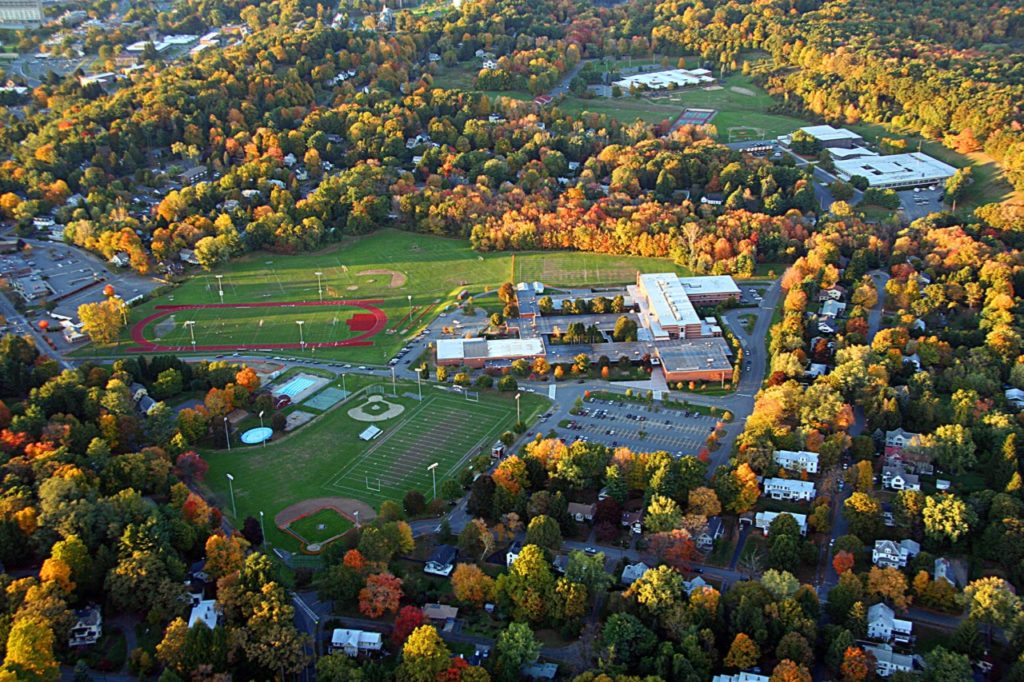High School Track Replacement Vies For Funding With Other Projects

Aerial view of the Amherst High School Campus. Photo: Chris Condit
Broad support for replacing the High School athletic track and interior field was expressed by the Regional School Committee on January 18, but questions remain about how to pay for it. In written public comments submitted to the committee, and verbal comments made by some committee members, support was greatest for the most expensive of the three options presented. Estimated at $4.65 million, this option includes a synthetic turf interior field, deemed preferable for year-round use and for sports such as field hockey that require a more even surface.
The track and field replacement is a capital project that would be paid for with a bond repaid over 10-20 years. To move forward, this project needs the approval of the Regional School Committee (which governs the middle and high schools) and each of the four town’s governing bodies. This differs from the approval process for all other capital projects (including for the elementary schools) as they are also subject to review by Amherst’s Joint Capital Planning Committee (JCPC). Funding for all capital projects, however, comes from the same limited pool, namely a portion of property taxes collected by the town.
Next fiscal year (FY23) the total capital budget is expected to be about $5.7 million, with debt obligations for already-approved projects, including any regional school projects, first taken off the top. What remains is what the JCPC has to recommend for things like roads and sidewalks, fire department vehicles, building roofs, and other tangible expenses. The need typically far exceeds available funds, leading to an increasing backlog, and this amount left over is slated to decrease further in the coming years as more debt payments will be due for larger projects such as the $36 million Jones Library renovation/expansion.
At the Finance Committee meeting on January 19, chairperson Andy Steinberg said that if the school committee wants to pursue the more complex (and hence more expensive) track and field project, “it really cuts into what the JCPC has as a total amount to recommend for other capital needs in the town.”
At this time of year, budgets are being prepared and departments are gathering their list of needs to present to the Town Manager and the JCPC. As Finance Director Sean Mangano wrote in last year’s budget, “The road ahead on capital will be challenging as we have seen…an increase in capital requests related to aging buildings and vehicles, and we are beginning to address the replacement of one or more buildings in town. To be successful, we will need to prioritize needs over wants.”
Understanding that much of the funding for the high school track and field would come from the same limited source as for all other capital needs and wants, will it be a need that rises to the top?

There are two problems that this one project is trying to address, and it’s causing a situation where a ‘perfect solution’ to both is delaying or preventing a good enough solution to either (or both separately).
Problem 1: the track need to be resurfaced
Problem 2: field hockey and lacrosse (and ultimate and soccer and perhaps other sport to a lesser degree due to the nature of those sports) have had to put up with sub-standard field conditions for decades
The design consultant hired to write a report on the fields situation instead created a bigger problem (politically) by trying to solve both issues with one solution, and creating an over-priced boondoggle of a project.
Simply resurfacing the existing track would cost $100 to 200K.
Building a new artificial turf field costs somewhere between $650,000 and $1,200,000.
Instead of wasting $15,000 on the consultant, a group of coaches and the current and former AD could have solved both problems for under $1 million.
Instead they have overreached and created an politically unsupported project, and prevented either of the original problems from being solved any time soon.
The original track, built in 2000 was designed to be resurfaced after 10 years. Why was that not done?
It’s now gone over 200% of it’s design life-span.
Instead of budgeting for appropriate regular maintenance of existing facilities, leaders have aimed for pie-in-the-sky over-spending on new unnecessary building, as they have with the Jones.
I would consider that a failure of leadership, but it seems like it’s par for the course and the general concept of this way of “budgeting” for “capital projects” is just the way things are done now days, and supported by the majority of elected and appointed officials and the voting public.
Except when they’re not.
Eric Nazar, former ARHS track coach